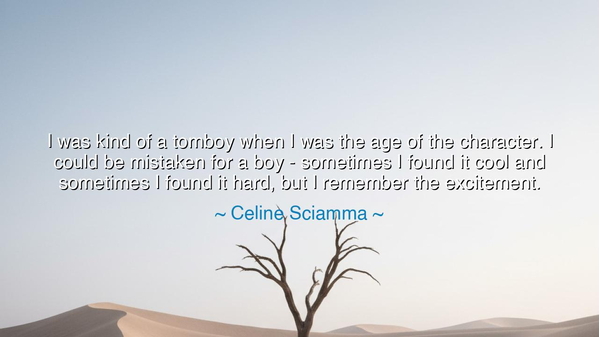
I was kind of a tomboy when I was the age of the character. I
I was kind of a tomboy when I was the age of the character. I could be mistaken for a boy - sometimes I found it cool and sometimes I found it hard, but I remember the excitement.






The filmmaker Céline Sciamma, known for her piercing explorations of identity and human becoming, once said: “I was kind of a tomboy when I was the age of the character. I could be mistaken for a boy — sometimes I found it cool, and sometimes I found it hard, but I remember the excitement.” In this reflection, she captures the delicate turbulence of youth — that sacred time when the self begins to take shape, yet remains fluid, restless, and undefined. Her words speak to the universal struggle between belonging and individuality, between the desire to fit in and the yearning to discover who we truly are. It is a confession not only of memory but of revelation — that identity, like life itself, is a journey of both confusion and wonder.
In the ancient style of wisdom, one could say that Sciamma’s words are a meditation on the beauty of transformation. The child, caught between worlds — not yet a woman, no longer a child — lives in a realm of constant becoming. To be a “tomboy,” in her sense, is not merely about playing rough or wearing different clothes; it is an emblem of the human condition itself: the freedom to move beyond the roles that others expect. She speaks of being mistaken for something she was not, and in that mistake lies a truth — that the world is quick to label what it cannot yet understand. Yet for Sciamma, this was not only struggle; it was excitement, the thrill of discovery, the electricity of realizing that identity is not fixed, but alive.
The origin of these words lies deep within Sciamma’s art, for she has always been a chronicler of the in-between — the liminal space between childhood and adulthood, masculinity and femininity, certainty and longing. In her acclaimed film Tomboy, she gave voice to this very feeling, painting with tenderness the story of a young soul exploring gender, joy, and belonging. Her own memory, she reveals, mirrors that story — not as a tale of rebellion, but as a dance with authenticity. To be mistaken for a boy, she says, was sometimes “cool” — a liberation from expectation — and sometimes “hard,” when the world resisted what it could not define. This duality, both thrilling and painful, is the essence of self-discovery.
The ancients understood this paradox well. The philosopher Plato, in his dialogues, spoke of the soul as a being divided, forever seeking to remember its wholeness. In every human life, there comes a time when one must stand apart from the tribe, face misunderstanding, and learn to walk one’s own path. In this, Sciamma’s “tomboy” phase is not merely a childhood anecdote — it is a rite of passage, the moment when the soul first feels the fire of its own freedom. Like the mythic heroes who left their homes to find their true names, so too does every young person step into uncertainty, and from that uncertainty draw strength.
Consider the story of Jo March from Louisa May Alcott’s Little Women. She, too, was a tomboy — fierce, unrefined, passionate, and misunderstood. Her refusal to conform to the expectations of femininity in her time made her both an outcast and a pioneer. Jo’s struggle mirrors Sciamma’s: the tension between the world’s definitions and one’s own sense of truth. Yet out of that tension was born greatness — for Jo became a writer, and her freedom became her power. Such is the eternal pattern: the discomfort of difference is the forge of identity. The “hard” and the “cool” coexist, and through both, one learns the art of becoming.
The excitement Sciamma recalls is the spark of awakening — the first taste of autonomy. It is that trembling awareness that one’s life belongs to oneself. In the ancient world, this moment was marked with ceremony — a child stepping into adulthood, a seeker facing the oracle, a warrior receiving the first scar of battle. In our time, it happens in quieter ways — in the moment someone dares to be different, to question, to wear what feels right even if it confuses others. Sciamma’s remembrance is a gentle reminder that the search for identity, though uncertain, is also joyous. The pain of not fitting in is, in truth, the birth cry of authenticity.
The lesson that flows from her words is this: do not fear the moments when you stand apart, for they are the moments when your true form begins to emerge. To live fully is to embrace the contradictions within you — to find strength in your uncertainty and meaning in your confusion. Whether the world misunderstands you or celebrates you, your task is the same: to remain loyal to the excitement of becoming. The “tomboy” in Sciamma’s story is every person who has ever walked between categories, who has ever refused to shrink to fit the mold.
So remember her wisdom, dear listener: the path to authenticity is not smooth, but it is sacred. Identity is not a destination — it is a living journey. The excitement she speaks of is the pulse of that journey, the heartbeat of transformation. Whether you find yourself mistaken, doubted, or misunderstood, let that not dishearten you. Instead, let it remind you that you are alive, growing, and daring to become. For in that daring — that beautiful, restless in-between — the true self is born.






AAdministratorAdministrator
Welcome, honored guests. Please leave a comment, we will respond soon